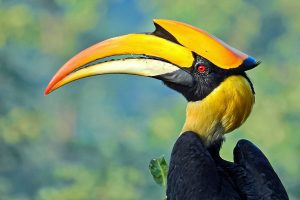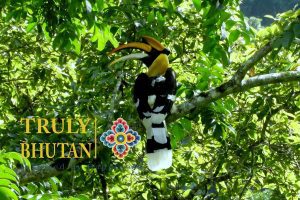Described as a natural paradise, while the world mourns the loss of its ecology, Bhutan has emerged as an example to the international community, an icon of preservation policies, with about 70 percent of its land still under forest and a great variety of rare plant and wildlife species. Its constitution mandates that under any circumstance 60 percent of its area should remain under forest cover.
One of the ten biological hotspots of the world, Bhutan is home to over 5,400 species of plants, including 300 species of medicinal plants, some thriving even at 3,700m above. It has 369 species of orchids, of which 82 are unique to the mountain country. Bhutan also boasts 46 rhododendron species.
Located between China and India, Bhutan’s terrain ranges from the subtropical foothills in the south, through the temperate zones, to dizzying heights of over 7,300 meters (24,000 feet). In Historical records, Bhutan was known as Lhojong Menjong ‘the Southern Valley of Medicinal Herbs.’ Besides these rare herbs, the Bhutanese seasons are reflected in full color by wildflowers and plants, which carpet the mountainsides.

While Bhutan as a winter roosting ground for Black Necked Cranes has been hugely emphasized, it is home to endangered species like:
- The Satyr Tragopan,
- Ward’s Trogon,
- Himalayan Monal,
- Blood Pheasants,
- Beautiful Nuthatch,
- Ibisbill,
- Rufous-necked Hornbill,
- White-bellied Heron,
- Varieties of Wren Babblers, and others.
The country’s national animal, Takin, and other mammals like:
- The Golden Langur,
- Common Langur,
- Capped Langur,
- Goral,
- Himalayan Black Bear,
- Golden-throated Martin and Flying Squirrels also live in Bhutan’s unsoiled terrains.
The other is the Bengal Tiger, which is even seen at altitudes higher than it is supposed to be.
Due to Bhutan’s location, and unique geographical and climatic variations it is one of the world’s last remaining biodiversity hotspots.
Bhutan’s pristine environment, with high rugged mountains and deep valleys, offers ecosystems that are both rich and diverse. Recognizing the importance of environmental conservation of its rich biodiversity is one of the government’s development paradigms.
The government has enacted a law that shall maintain at least 60% of its forest cover for all time. Today, approximately 72% of the total land area of Bhutan is under forest cover and approximately 60% of the land area falls under protected areas comprising 10 national parks and sanctuaries.
National Parks and Wildlife Sanctuaries in Bhutan
Each of Bhutan’s National Parks and Wildlife Sanctuaries is an essential part of the Bhutan Biological Conservation Complex – a system of national parks, protected areas, and forest corridors covering 60% of the kingdom. Each of these parks and sanctuaries has its special character and is home to endangered animals, birds, and plants.
Jigme Singye Wangchuck National Park
Located in the central part of the Kingdom, Jigme Singye Wangchuck National Park covers 1,300 sq. km and is the second largest protected area of Bhutan.
High ice peaks fall away to low conifer and broadleaf forests. The park remains one of the largest undisturbed tracks of forest anywhere in the Himalayas. Varying altitudes and rainfall have created a wide range of climatic conditions, making it home to many species of plants, animals, and birds.
Both musk deer and Himalayan black bear can be found here. The golden langur that is quite common in Bhutan, the rare clouded leopard, the red panda, and the Royal Bengal tiger are among some of the many species found here. The Eastern side of the park supports about 20% of Bhutan’s tiger population and the park itself forms an important link between northern and southern tiger populations.
It is also home to 391 bird species of which seven species are among some of the world’s most endangered species. Phobjikha valley, a buffer zone to the park, is the winter habitat of Black Necked Cranes. More than 260 majestic cranes visit Phobjikha every year towards the end of November.
Thrumshingla National Park
Situated in the very heart of the kingdom covering 768 sq. km was officially opened in July 1998.
Pristine forests ranging from alpine to subtropical broadleaf combined with dramatic mountains are home to snow leopards, tigers, red pandas, and rare plants. This creates a globally important and unique environment.
With its elevation ranging from 1,000 m to more than 4,000 m, and temperature ranging between –21 C to +28 C, the park has some of the most diverse climatic variations and habitats in the world. The park made news in 2000 when a WWF-supported survey team captured a camera-trap image of a tiger at 3,000 meters. The first photographic evidence of the magnificent creature exists at such high altitudes. Besides that, the park has 341 species of birds making it truly a birdwatcher’s paradise.
Tourism helps to sustain the lives of communities within the park, with an effective management plan in place and dedicated park staff along with WWF support. The park is set to remain in pristine condition for generations to come.
Royal Manas National Park
Bhutan’s Crown Jewel, the Royal Manas National Park is Bhutan’s oldest national park representing the largest example of tropical and sub-tropical ecosystems in Bhutan.
This park has only recently been opened to the public and offers thousands of animal and plant species, many of which are globally endangered. It is not only the most diversely protected area in the Kingdom but is also noted as one of the world’s biologically outstanding parks.
Lying in south central Bhutan, the park is connected at the southern border with India’s Manas Tiger Reserve, a World Heritage Site. To the north, it borders Jigme Singye Wangchuck National Park. Royal Manas was designated a wildlife sanctuary in 1966 making it Bhutan’s oldest protected area. The area was upgraded to a National Park in 1993.

There are wide climate variations in Royal Manas Park. May-September monsoons bring up to 5,000 mm of rain. Rainfall is negligible in winter and the climate is extremely pleasant from November to March.
The park is also extremely rich in wildlife species, including the highly endangered Royal Bengal tiger, Asian elephant, great one-horned rhinoceros, clouded leopard, Himalayan black bear, gigantic dolphin, and pangolin. Found virtually nowhere else in the world is the especially rare golden langur, a primate of extraordinary grace and beauty with its long, silky blond fur.
More than 365 species of birds have been officially recorded in Royal Manas National Park with an additional 200 believed to be in residence. Species found here include the globally threatened Rufous-necked hornbill, Pallas fishing eagle, great white-bellied heron, spotted wren-babbler, blue-headed rock thrush, and emerald cuckoo. Many of the park’s more than 900 types of plants have commercial, medicinal, traditional, and religious significance.
Jigme Dorji National Park
With an area of 4,349 sq. km, the park is the largest protected area in Bhutan. It is one of the most biologically rich areas in the Eastern Himalayan region and stretches from warm broad-leaved forests to permanent ice fields and glaciers on Bhutan’s northwestern border.
The monsoon rains and a varied topographical gradient, from just over 1,000 m to more than 7,000 m above sea level account for this rich plant and animal diversity.
Sacred peaks such as Jomolhari, Tserimgang, and Jichu Drakey are prominent landmarks in the park. Glaciers and glacial lakes are interspersed in the mountains forming important headwaters for some of Bhutan’s main rivers.
The alpine region houses numerous flowers such as the national flower blue poppy, edelweiss, orchids, and rhododendrons among many others. Charismatic animal species like the Snow Leopard, Takin, Tiger, Black Bear, Blue Sheep, and Red Panda inhabit the forests and mountains of the park. This may be the only place in the world where the Royal Bengal tiger and snow leopard habitats overlap. Most of Bhutan’s popular trekking routes can be found inside the Jigme Dorji National Park.
Bundling Wildlife Sanctuary
Bumdeling Wildlife Sanctuary is located in the northwestern part of Bhutan covering an area of 1,545 sq. km with 420 sq. km of buffer zone encompassing parts of Trashiyangtse, Lhuntse, and Mongar districts. It shares international borders with the Tibetan region of China in the north and India in the northeast. The sanctuary is home to around 100 species of mammals, including globally endangered species such as the snow leopard, Royal Bengal tiger, and red panda.
About 150 black-necked cranes spend their winter in Bumdeling every year from mid-November to early March. Bumdeling Wildlife Sanctuary is also a paradise for butterflies: as of now, 130 species have been recorded and another 120 are expected to inhabit this area. Besides natural beauty and diversity, many significant religious and cultural places can be found inside the sanctuary, such as Rigsum Gompa, the mystic Singye Dzong, and Dechen Phodrang Lhakhang may be the most scenic monastery in the kingdom.
Sakteng Wildlife Sanctuary
Located in the easternmost part of the Kingdom, Sakteng Wildlife Sanctuary spans an area of 650 sq. km and is Bhutan’s newest protected area (launched in 2003). The sanctuary is a lost world of biodiversity waiting to be discovered. It presents a wide diversity of Himalayan terrestrial ecosystems, namely alpine meadows, temperate forests, and warm broadleaf forests.
The Sanctuary is home to people of isolated nomadic tribes. It is characterized by thick carpets of rhododendrons and is home to snow leopards, red pandas, Himalayan black bears, barking deer, Himalayan red fox, hoary-bellied Himalayan squirrel, and even the mythical Yeti or the “Abominable Snowman”. Sakteng is virtually untouched by development. Bird species include the Assamese macaw, blood pheasant, grey-backed shrike, grey-headed woodpecker, common hoopoe, rufous vented tit, and dark-breasted rosefinch.
Plant life includes Bhutan’s national flower the blue poppy, rhododendrons, Primula, and Gentiana, all of which transform the park into a garden of colors during springtime. There are also many plants with medicinal values- such as Cordyceps.
Khaling Wildlife Sanctuary
With an area of 273 sq. km, this is the smallest protected area in the kingdom.
Despite its relatively small total area, this sanctuary’s altitude ranges from 400-2200m and it is inhabited by exotic animals like Elephants, Guars, Pygmy Hogs, and Hispid Hares. As it is located on the kingdom’s southern border, Khaling Wildlife Sanctuary adjoins a neighboring Indian wildlife sanctuary.
Phibsoo Wildlife Sanctuary
This relatively small protected area is located near the Southern border with India, approximately 50 km from Phuntsholing.
It encompasses 278 sq. km. And ranges from 200-1600 m in altitude. It is home to rare and exotic animals such as Elephants, Tigers, Gaurs, Spotted Deer, Axis Deer, Hornbills, and Golden Langur. This park is Bhutan’s only natural, Sal Forest.
Wangchuck Wildlife Sanctuary
The Wangchuck Centennial Park was formally inaugurated as a National Park in June 2008. With an area of 4149 sq. km, it is the largest National Park in the kingdom. Several high mountains such as Mt. Gangkar Puensum are found within the park’s boundaries.
The park is located in the north-central region of Bhutan and encompasses regions of 6 different Dzongkhags. With Bumdeling Wildlife Sanctuary to its East, Jigme Dorji National Park to its West, and a continuous biological corridor to its South, the park is a crucial part of a network of protected areas in Bhutan.
Within the park, there are two main types of vegetation, Fir trees, and Hemlock, Spruce, and Juniper trees. It encompasses three ecological zones and 6 different habitat types namely cool broadleaf forests, mixed-conifer forests, Fir forests, Juniper forests, Alpine meadows and Scrubs, and Alpine Scree.
The Wangchuck Centennial Park is home to several incredibly rare and protected species such as the Royal Bengal Tiger, Snow leopard, and Himalayan Musk Bear.
Toorsa Strict Nature Reserve
Located in Western Haa, the Toorsa Strict Nature Reserve covers an area of 644 sq. km.
It ranges in altitude from 1400-4800 m and its vegetation includes Broad-leaved Forests and Alpine Meadows. This is the only nature reserve in the kingdom that has absolutely no human inhabitants.
